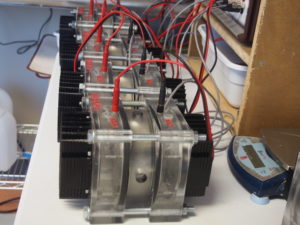We often — mistakenly — refer to ASTM C1202, “Standard Test Method for Electrical Indication of Concrete’s Ability to Resist Chloride Ion Penetration,” as the Rapid Chloride Permeability test. Permeability refers to the movement of a liquid or gas through a porous solid. What we want to know is how readily chloride ions move through the concrete. That is, we want to know about the diffusion of chlorides through concrete. ASTM C1202 measures the electrical conductivity of the concrete. Is it any wonder people are confused about it?
Concrete is a porous material. If the pores are continuous, it’s easy for water to permeate it or for ions to diffuse through it. If the concrete is saturated with water, ions from the hydrated cement will dissolve in the pore water, making it electrically conductive. So the electrical conductivity is an indirect indicator of what we really want to know. That is, a concrete that’s highly conductive will also have a high diffusivity.
True diffusion tests such as AASHTO T 259 take a long time to perform. Diffusion is driven by a concentration gradient: ions migrate through the solution to where the concentration is lower. The process is somewhat faster at higher temperatures, but it’s still pretty slow. And the better the concrete, the longer it takes. For a highly durable concrete, you should give it six months’ exposure to a chloride-ion solution before you can expect to get meaningful data. Add the time it takes to make and cure the concrete before the test and the time you need to sample and analyze the concrete at the end, and you have an 8- or 9-month test. Clearly any true diffusion test is going to work only for laboratory research, not for practical applications in the field. Hence the interest in indirect tests.
A brief history of ASTM C1202

Dr. David Whiting, then at the Portland Cement Association, developed ASTM C1202 in the early 1980s for the Federal Highway Administration. It’s a simple, quick test to compare the relative electrical conductivity of different concretes. At the time, it correlated well with the results from AASHTO T 259, the ponding test that measures diffusion directly.
Back in the day, concrete-making materials comprised portland cement, water, aggregates, and some very basic chemical admixtures. Fly ash, slag cement, and other supplementary cementitious materials were available, but hardly anyone used them.
As mentioned above, the continuity of the pores directly affects the permeability, diffusivity, and electrical conductivity of the concrete. However, the conductivity of the pore solution also matters. If the concrete contains slag cement, fly ash, or silica fume, its pore solution will have different proportions of the various ions. As a result, the electrical conductivity will be different even if the diffusivity is the same. Slag cement, for example, lowers the electrical conductivity far more than it lowers the diffusivity. Calcium nitrite admixture in the concrete dramatically increases the conductivity.
Over time, researchers found that other factors also affected the test. If the concrete is too conductive, it may get hot enough to boil the solutions in the test cell. To keep that from happening, the technician monitors the temperature and discontinues the test before it gets that hot.
Despite the limitations, ASTM C1202 became very popular for specifications of concrete for bridge decks and parking garages. While AASHTO T 259 is too slow for anything but laboratory research, ASTM C1202 is fast enough to use for quality control testing.
How and what to specify
Once engineers realized they had a test they could use for quality control, the next question was, “How good is good enough?” ASTM C1202 is really a semiquantitative test. The measurement you get is expressed as the total charge passed in 6 hours. You can categorize it as high (>4000 coulombs), moderate (2000-4000 coulombs), low (1000-2000 coulombs), very low (100-1000 coulombs), or negligible (<100 coulombs). However, none of these values correlates directly to durability. You can’t, for example, use the test result in a service-life prediction model.
Even so, specifications started to include maximum values of 1500 coulombs, then 1000 coulombs, and sometimes even as low as 500 coulombs. It’s hard to say whether 1000 coulombs is objectively better (that is, more durable) than 1500 coulombs. It’s a lot easier to estimate the additional cost of consistently producing concrete that meets these requirements. One clear benefit, though, is that low coulomb requirements forced engineers to use supplementary cementitious materials in their concrete. It’s the only cost-effective way to get very low or negligible ratings with ASTM C1202.
Nowadays, we have better tests that we can use to predict the service life of concrete. These include NT Build 492 and ASTM C1556. Beton can help you include these tests in your specification or develop a concrete that meets your requirements.
